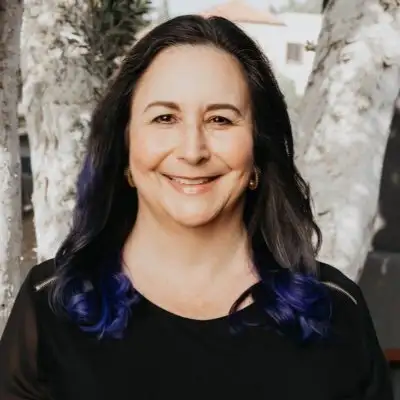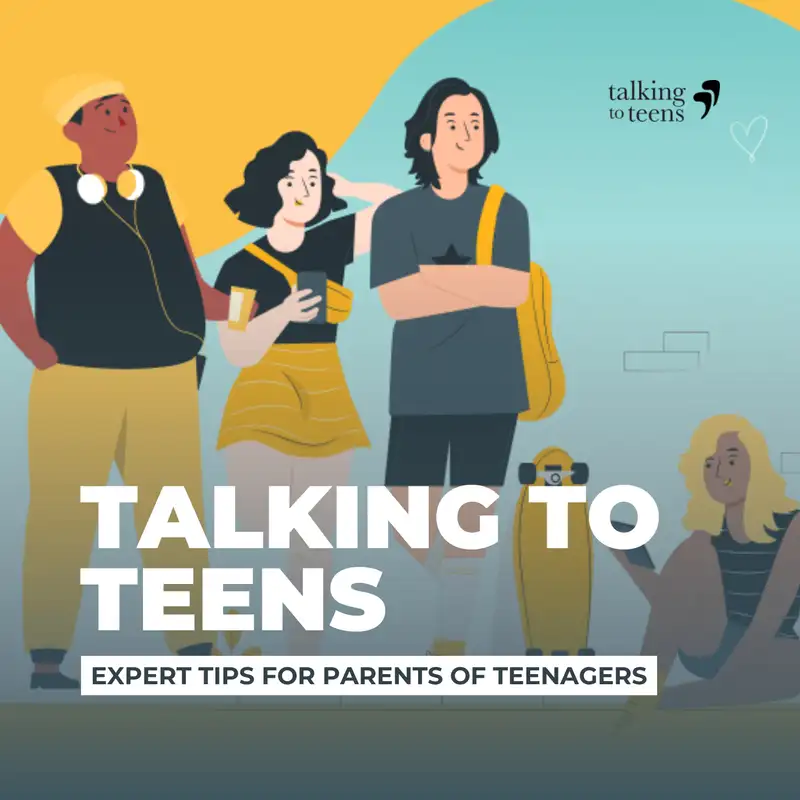Ep 93: How to Spot & Treat Eating Disorders
Andy:
So the book is, When Your Teen Has an Eating Disorder, Practical Strategies to Help Your Teen Recover From Anorexia, Bulimia and Binge Eating. And you kind of go through this family based approach, which is, I think really encouraging for parents, and really shows that parents can make a difference and that parents are hugely important in the teens recovering from eating disorders. First, can you talk a little bit about how you got into this and how you developed this area of interest and expertise?
Dr. Muhlheim:
Sure. Thanks so much for having me. I'm a psychologist, and in grad school I trained in a bulimia research lab and developed expertise in working with adults with bulimia. And then in 2008 to 2010, I found myself in Shanghai, China accompanying my husband who was working there. And when I said I had eating disorder experience, I started to get referrals of adolescents with eating disorders, and I quickly realized that I didn't have the skills to work with that population. And family based treatment was the leading evidence-based treatment at the time. And so I flew to Stanford and did the training, and then shortly thereafter repatriated back to the U.S. and sought more training in family based treatment, got certified, and later on wrote the book.
Andy:
And so what is family based treatment, and what makes it different than other approaches and how does it work?
Dr. Muhlheim:
So family based treatment was originally developed at the Maudsley Hospital in the UK in the 90s, and it was later brought to the U.S. to Stanford by Jim Locke and Daniel LaGrange who wrote the manual and named it Family Based Treatment, or FBT. It's sometimes called the Maudsley Method because it was developed at the Maudsley Hospital in the UK, but Maudsley Hospital has developed many treatments so they do not call it that that.
Andy:
Sure, that would be confusing.
Dr. Muhlheim:
Some parents early on brought the term out Maudsley to try to identify FBT, family-based treatment, is different from traditional family therapy, which had often been used. And there is a big distinction. So traditional family therapy for eating disorders saw the eating disorder as the expression of a family conflict, so the treatment focused on changing family alignments and behavior patterns to help the sick child who was exhibiting the symptom to get well. But family based treatment, or FBT, is a totally different treatment. It's a behavioral treatment primarily, and it focuses on empowering the parents to be the agents of change to get their child well. So it doesn't believe that family functioning is the source of the problem. It is agnostic about cause, but it really focuses on parents being an important part of the solution, which is different than a lot of other treatments for eating disorders. And parents have been blamed for eating disorders since way back in the 1600s when early researchers said that parents were the worst attendance.
Dr. Muhlheim:
And so, this backdrop and further psychoanalytic thinking saw parents and mothers as the source of the problem. And so treatment focused on sending the adolescent away to get fixed, and then once they were fixed, they could come back home. But Jim Locke, who was at Stanford, he would send teens to the hospital, they would get fixed up, they would go home and then they would relapse. And the cycle continued. And he said, one explanation was that parents were the problem, but another explanation was that parents just didn't know how to do what we needed them to do, which was ensure recovery behaviors. So that's what family based treatment really is. It's installing parents as important parts of the treatment team where they help their teen to, number one, eat enough to gain weight if they need to restore weight, and number two, to prevent eating disorder behaviors, whether it's over-exercise, purging, hiding food, all those things that the eating disorder likes to make teens do.
Andy:
If I'm a parent and I'm listening to this and I'm thinking, I'm just not sure if my teen is at a place where I should do something or if I should intervene, what are the signs to look for? How do I know when it's kind of crossed the line and when, hey, this has really gotten to a point where I need to step in as a parent and I need to take action and do something?
Dr. Muhlheim:
Yeah, that's a really good question. I think if you're concerned as a parent, definitely listen to your instincts. So many times parents regret not acting sooner, and the risk of overreacting is much lower than the risk of waiting. And unfortunately many even health professionals encourage families to wait. But especially anorexia can take on a life of its own so quickly and become an entrenched disorder that can take many, many years for a teen to recover from, that I always encourage if you're concerned to do something about it. If you are concerned that your child is under eating, it's a very easy intervention to make sure that your child is eating enough.
Dr. Muhlheim:
I actually wrote an article with a colleague about using FBT as an early intervention, and how each of us who had been FBT trained saw some little behavior in one of our children that concerned us, and so each of us did a little mini intervention. And we don't know if it prevented an eating disorder that would have definitely come, but certainly there were no negative repercussions of the interventions that we did, which was essentially requiring our teens who were showing some mild worrisome signs, making sure they were eating enough and gaining weight according to their growth curve, which is something that I think any parent can pretty much do. Pediatricians are so worried about people being larger.
Andy:
Overweight, right.
Dr. Muhlheim:
Yeah. I don't even like to use that term. And my children's own pediatrician missed that. After this intervention, when I looked back and charted her growth curve, my daughter had totally fallen off her growth curve and the pediatrician didn't notice that, it was only when I plotted it. And in fact, the sample growth curve in the book is actually my daughter's own growth chart, and she was never diagnosed.
Andy:
Interesting.
Dr. Muhlheim:
Yeah, it is fascinating. And so I always encourage parents to look at that growth chart, that your child pretty much typically grows along a trajectory, and there's a height curve, and a weight curve and a BMI curve. And I suggest just looking at the height curve and the weight curve, and kids who normally grow along the 75th percentile, that is usually totally normal for them. And some will grow along the 75th percentile, some will go along the 50th, some will grow along the 20th, some will grow along the 90th, and the height and the weight don't have to match. But just take a look at that and see if your child is keeping up with whatever trajectory they were on, and if they're not, then I would seek some assistance or at least think about using some of these strategies.
Andy:
It's really striking with the example that you have in the book. You can really see the difference where it kind of starts to veer off of what the growth curve that she was on, really on the high end when she was younger, and then started to go down, then past then there's the dotted line that's the 50% dips below that. So it's just a really good visual, I think that anybody could keep track of and do, and makes it easy to know when something has changed.
Andy:
What is the Ancel Keys' Minnesota Starvation Study and what does it tell us about the way starvation affects the brain?
Dr. Muhlheim:
Yeah, so that was a really fascinating study done in the 1950s. They took conscientious objectors to the war, and they screened men in their 20s who were very healthy on all psychological and physical measures, and they put them on a six month semi starvation diet, which meant decreasing their caloric intake by half. So the men were typically eating about 3,600 calories a day and they reduced it to about 1800 calories a day. And over time, these men exhibited almost all of the symptoms of that we would consider symptoms of anorexia. So they were anxious, obsessed about food, they were cold, and some were over-exercising and they were extremely anxious and depressed. And we point to this study now to show how significant the malnutrition in an eating disorder is in a lot of the symptoms that we see.
Dr. Muhlheim:
And this is something parents come to me and their kid is not eating enough, and overexercising, and extremely anxious and depressed. And it's kind of like, where do we start? And I always recommend starting with the nutrition, and getting the regular meals in, and getting the weight up and making sure they're eating enough. And oftentimes a lot of the anxiety and depression gets better, and that is because malnutrition has such a big impact on all systems of the body and everyday functioning and mood. A lot of parents find that, and what we say in FBT, is that food is the medicine, and food is the medicine that's going to help your teen to fully recover. And so that's one of the gifts of FPT is really the focusing on the food and the family meals as the centerpiece of treatment.
Andy:
You have an important concept in here called a negative energy balance. What is that and how does it work differently in people who develop anorexia?
Dr. Muhlheim:
So it seems that people who have the propensity to develop anorexia respond differently to this negative energy balance. So negative energy balance is when a person at any weight does not take in enough to support their body's needs. This can be through over-training, we see this in kids who their hunger maybe doesn't keep up with their growth or the amount that they're expending in athletics. And it appears that the negative energy balance impacts the brain in a way that the teens who have this predisposition get stuck, they get more anxious, they feel calmer when they don't eat so they eat less. And then all these brain changes happen that keep an individual stuck with not eating enough. And so, again, that's another reason why food is prioritized in this treatment and is such an essential part of recovery.
Andy:
Okay. So when you say food is prioritized, what does that mean? How do you prioritize food?
Dr. Muhlheim:
So some parents interpret this as life stops until you eat, and that's kind of a saying that parents have. But basically it means that your teen has to eat regularly throughout the day. We usually start recovery meal plans with three meals and three snacks evenly spaced throughout the day. The meals need to be energy dense enough for your teen and their needs. Many parents who have been impacted by diet culture have no idea how much teens truly need to eat. It's way more than most parents think. And recovery meal plans are even much higher because you're trying to replenish, and then many kids become hypermetabolic. So recovery meal plans are often 3,000 to 6,000 calories a day.
Andy:
That's not easy.
Dr. Muhlheim:
No, it's not. It's challenging, especially if the eating disorder prefers super healthy foods.
Andy:
Yeah. Right, right. That's a lot of salad.
Dr. Muhlheim:
And that's part of the struggle, right? So yeah, so we really prioritize getting those meals in and using a lot of structure and a lot of basically requirements that your child can't go to school unless they've eaten breakfast, and they can't go back into school if they haven't eaten lunch, and putting the meals first over everything else, because they really are the medicine. So we really emphasize prioritizing all the meals and treating it as the essential medicine that your child needs.
Andy:
Okay. So you mentioned you and some of your colleagues have had to do kind of smaller versions of this with your own kids or something. What does that look like, I guess, or what are the different kinds of levels of how you can implement this? You talk in the book about even going to school with your kid if you have to and eating with them in the car or supervising them while they eat. How can you calibrate it?
Dr. Muhlheim:
Yeah. So for a lot of the kids I see in my practice, they have 20 and 40 pounds to restore or growth to catch up that they've failed to grow and keep up with their growth curve. And that's another thing about the spotting it, is many parents are not aware that failure to gain is for a teen the same as weight loss in an adult. So many parents may not notice a problem, it's just their teen hasn't gained any weight. So many of the kids I see in my practice have a lot of weight to restore, so meals have to be really high calorie and the supervision is important. And a lot of teens where this has been going on longer have incredible amounts of anxiety and meals are terribly difficult. So, a lot of kids end up going to residential and higher levels of care, and FBT can, in some cases, be an alternative to that.
Dr. Muhlheim:
And so, it's like running a residential treatment center in your home for your one child where you are the staff and you prepare, serve and supervise all the meals, and they have to be supervised because anorexia and bulimia make kids do things that they wouldn't normally do, like hide food, and kids get upset, and violent and aggressive sometimes during meals. So that can be really tough. And I have many parents who have to pull the teen out of school for a while, take off work, stay home with them, or get relatives to come in and assist. So that's kind of not uncommon. A kind of middle phase is where the kid can still go to school, but the parents often have to go to school to supervise lunch because the teen is unable to eat on their own, and it's too long a day to go without those meals.
Creators and Guests



